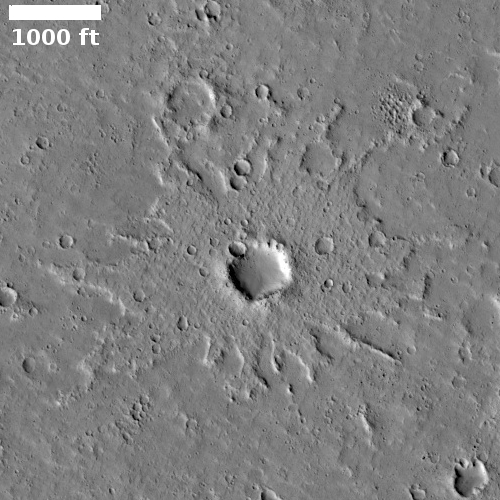A Mars mosaic from Curiosity using its close-up camera
During the three-plus months in the summer when Curiosity stayed at one location for its most recent drilling campaign, the science team used its ChemCam Remote Micro-Imager camera (RMI), originally designed to take very close-up photos, to create a 216 photo mosaic of the long distance horizon. They have now released that mosaic, which you can see as a video at the link. The mosaic itself is a very long strip, which is best viewed up close and scrolling across it, as the video does. As the scientists note,
During Curiosity’s first year on Mars, it was recognized that, thanks to its powerful optics, RMI could also go from a microscope to a telescope and play a significant role as a long-distance reconnaissance tool. It gives a typical circular “spyglass” black and white picture of a small region. So RMI complements other cameras quite nicely, thanks to its very long focal length. When stitched together, RMI mosaics reveal details of the landscape several kilometers from the rover, and provides pictures that are very complementary to orbital observations, giving a more human-like, ground-based perspective.
From July to October of 2020, Curiosity stayed parked at the same place to perform various rock sampling analyses. This rare opportunity of staying at the same location for a long time was used by the team to target very distant areas of interest, building an ever-growing RMI mosaic between September 9 and October 23 (sols 2878 and 2921) that eventually became 216 overlapping images. When stitched into a 46947×7260 pixel panorama, it covers over 50 degrees of azimuth along the horizon, from the bottom layers of “Mount Sharp” on the right to the edge of “Vera Rubin Ridge” on the left.
The camera’s resolution is so good that it was able in the mosaic to resolve large boulders on the crater wall of Gale Crater almost 37 miles away.
During the three-plus months in the summer when Curiosity stayed at one location for its most recent drilling campaign, the science team used its ChemCam Remote Micro-Imager camera (RMI), originally designed to take very close-up photos, to create a 216 photo mosaic of the long distance horizon. They have now released that mosaic, which you can see as a video at the link. The mosaic itself is a very long strip, which is best viewed up close and scrolling across it, as the video does. As the scientists note,
During Curiosity’s first year on Mars, it was recognized that, thanks to its powerful optics, RMI could also go from a microscope to a telescope and play a significant role as a long-distance reconnaissance tool. It gives a typical circular “spyglass” black and white picture of a small region. So RMI complements other cameras quite nicely, thanks to its very long focal length. When stitched together, RMI mosaics reveal details of the landscape several kilometers from the rover, and provides pictures that are very complementary to orbital observations, giving a more human-like, ground-based perspective.
From July to October of 2020, Curiosity stayed parked at the same place to perform various rock sampling analyses. This rare opportunity of staying at the same location for a long time was used by the team to target very distant areas of interest, building an ever-growing RMI mosaic between September 9 and October 23 (sols 2878 and 2921) that eventually became 216 overlapping images. When stitched into a 46947×7260 pixel panorama, it covers over 50 degrees of azimuth along the horizon, from the bottom layers of “Mount Sharp” on the right to the edge of “Vera Rubin Ridge” on the left.
The camera’s resolution is so good that it was able in the mosaic to resolve large boulders on the crater wall of Gale Crater almost 37 miles away.






